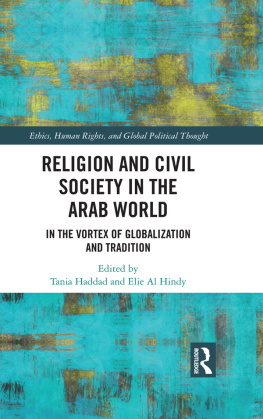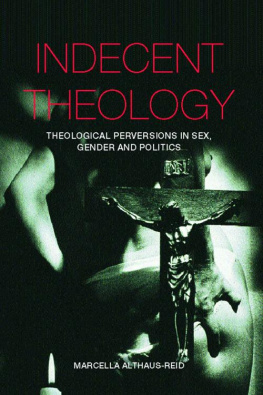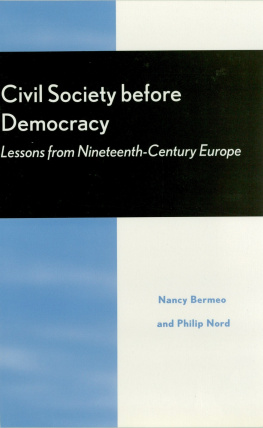The Changing & Unchanging Face of U.S. Civil Society
First published 2002 by Transaction Publishers
Published 2017 by Routledge
2 Park Square, Milton Park, Abingdon, Oxon OX14 4RN
711 Third Avenue, New York, NY 10017, USA
Routledge is an imprint of the Taylor & Francis Group, an informa business
Copyright 2002 by Taylor & Francis.
All rights reserved. No part of this book may be reprinted or reproduced or utilised in any form or by any electronic, mechanical, or other means, now known or hereafter invented, including photocopying and recording, or in any information storage or retrieval system, without permission in writing from the publishers.
Notice:
Product or corporate names may be trademarks or registered trademarks, and are used only for identification and explanation without intent to infringe.
Library of Congress Catalog Number: 2001058305
Library of Congress Cataloging-in-Publication Data
Ray, Marcella Ridlen.
The changing and unchanging face of U.S. civil society / Marcella
Ridlen Ray; with a foreword by Francis Fukuyama.
p. cm.
Includes bibliographical references and index.
ISBN 0-7658-0139-6 (cloth: alk. paper)
1. Political participationUnited States. 2. Civil societyUnited
States. I. Title.
JK1764.R39 2002
300'973dc21
2001058305
ISBN 13: 978-0-7658-0139-5 (hbk)
To Charles and to most Americans who, wittingly or unwittingly, produce civil society each day
The author gratefully acknowledges the Brookings Institution Press for permission to use previously published material that appeared in Civic Engagement in American Democracy , edited by Theda Skocpol and Morris Fiorina.
I am indebted to many for assistance in the research and writing of this book. Support was outstanding from sources within George Mason University: the School of Public Policy, the Department of Sociology and Anthropology, the Department of Public and International Affairs, and Fenwick Library. The Joseph L. Fisher Doctoral Award in recognition of this research symbolizes the encouragement I received.
The researchers obsession is access to data and there are many who made this possible. I thank busy editors of the Encyclopedia of Associations who answered questions about the compilation of their reference work, Census Bureau researchers who shared unpublished data, always responsive researchers at the Independent Sector, editors of the Standard Directory of Periodicals who supplied data with which to construct trends, American Business Directories who furnished annual sales lists enumerating membership groups listed in yellow page directories, and the American Society of Association Executives who shared some of their own research results. Staff from Harris Polls, Gallup, Pew Research Center, Hart Teeter and the Roper Organization helped with searches of survey databases. Invitations from the Independent Sector, the Internal Revenue Service, and National Association of Latino Elected and Appointed Officials to make use of their in-house collections were so helpful. My gratitude to librarians at the Library of Congress, George Mason University, the Internal Revenue Service, the Oxford Union, and the Social Studies Library at Oxford is immense.
Marty Lipset tops the list of people whom I must thank. Marty patiently and dispassionately read and critiqued drafts of this work as it unfolded. I am indebted to Frank Fukuyama for his interest in my work and his thoughtful support of an emergent scholar. Tim Conlan and Hugh Heclo were beyond generous with their encouragement and suggestions. John Stones review of my analysis of Tocqueville was important. A small working conference on Civic Engagement in American Democracy brought thoughtful suggestions from Stephen Brint, Theda Skocpol, Mo Fiorina, Robert Putnam, and Jeff Berry in regard to technological aspects of associational life. I warmly acknowledge contributions of Ingrid Sandole-Staroste, Amy Bunger, Gwen Halford, Gerard Maas, Susan Roche, Miriam Riskind, Reza Banakar, Laura Matthews, Sandra Doyle, Lisa Bodgwick, and Mark Almond. Without the family and friends who sacrificed on its behalf, this project would not have come to fruition. And what would one do without a masterful editor like Anne Schneider, who like a symphony conductor brings it all together? Finally, I thank my life partner for his infinite patience, his always enthusiastic backing of this project, and for caring about the public interest.
One of the key features of the debate over the state of democracy at the end of the twentieth century and the beginning of the twenty-first has been the centrality of civil society to the discussion. The idea that intermediary groups standing between the individual and the state should be key to the success of liberal democracy has been around since Tocqueville. But the need to build civil society as a practical project arose in an acute way with the collapse of the Soviet empire in 1989 and the rise of a number of new democracies in former communist countries. The notion that civil society could not be taken for granted, that it was stronger in some societies than in others, and that it could actually disappear, became questions not just of theoretical but of immense practical importance.
Consonant with Alexis de Tocquevilles observation of the importance of voluntary associations to American democracy, some of the greatest worriers about the state of civil society have been Americans. Scholars like Edward Banfield, Gabriel Almond, and Robert Putnam have been important in laying out a theory of the relationship of civil society to other democratic institutions, while various pollsters, social scientists, and observers of all stripes have been busy over the years gathering empirical evidence about the relative health of intermediary institutions both in the United States and abroad. The debate over the health of American democracy in the 1990s was strongly shaped by Putnams article, Bowling Alone, later turned into a book, which asserted that American civil society had gone into a generation-long decline in the postwar period as a result of civic disengagement on the part of the baby boom generation.
The Changing and Unchanging Face of U.S. Civil Society constitutes an important contribution to this ongoing debate. Using data sources untapped by Putnam, as well as reinterpreting existing data in different ways, Marcella Ridlen Ray contests his central finding that American social capital has been in decline. She argues instead that the types and forms of civic association have changed over times in a flexible manner that adapts to changing conditions. In particular, they have adapted to the requirements for greater inclusiveness that have changed the character of how and with whom Americans associate. She argues that the ability of American civil society to reinvigorate itself is undiminished.
Americas response to the terrorist attacks of September 11, 2001, reinforces her point. In the face of an unprecedented external threat, Americans have suddenly found new sources of community and mutual support that had little precedent in the preceding economic boom years that formed the backdrop to Putnams analysis. Patriotism came back in fashion (as evidenced by the ubiquitous flags following the attacks), there was an enormous outpouring of concern and active help to the victims, and, at least anecdotally, a greater interest in public service and public issues more generally. Even if Putnam were clearly right that American social capital had been in decline, it could well turn out that the single day of September 11 was sufficient to reverse some of the most important of the negative trends he chronicled.





